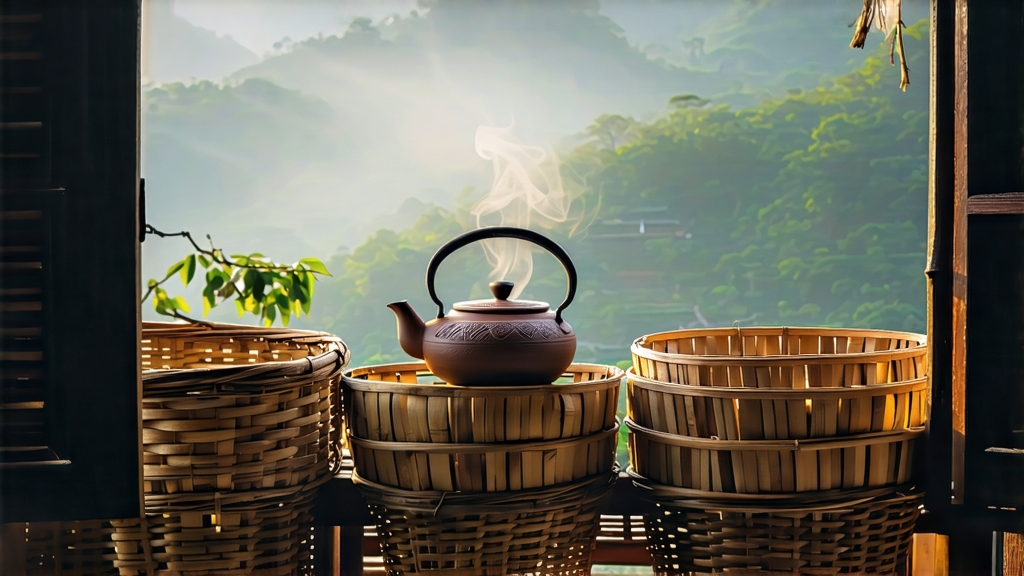
Liu Bao, literally “Six Forts,” is the quietest celebrity in the world of dark tea. While Pu-erh hoards the spotlight, this cousin from Guangxi has spent four centuries maturing in bamboo baskets, absorbing mountain mist and river fog until its leaves turn the color of rusted iron and its liquor glows like burnt amber. To meet Liu Bao is to step into a limestone karst landscape where the West River bends, where horse hooves once echoed on the Tea Road to Southeast Asia, and where every sip still carries the humidity of subtropical forests.
History: From Border Garrison to Maritime Silk Road
The name Liu Bao refers to the six ancient stockades that guarded the county of Cangwu during the Ming dynasty. Soldiers stationed there received compressed tea as part of their rations; the bricks traveled well and resisted mold in the sultry climate. By the Qing era, Liu Bao had become currency along the Maritime Silk Road, sailing from Wuzhou port to Malacca, Jakarta, and even Calcutta. Dockworkers noticed that the tea tasted smoother after the monsoon voyage; the rocking holds and salt air had coaxed out a mellow, medicinal sweetness. Chinese migrants in Southeast Asia adopted it as a remedy for fever and indigestion, boiling it with ginger and rock sugar in kopitiams. Thus a frontier ration evolved into a diaspora comfort, a taste of home that improved with every nautical mile.
Terroir: Where Rocks Breathe and Rivers Hum
Guangxi’s karst peaks rise like stone organ pipes, trapping cloud moisture that keeps the average humidity above 80 %. The soil is a reddish calcareous clay laced with crushed limestone; it drains quickly yet holds minerals that tea roots slowly sip. Liu Bao bushes grow between 200–500 m elevation, often interplanted with cinnamon and pomelo trees whose roots share mycorrhizal networks, adding subtle woody notes to the leaf. Two cultivars dominate: the large-leaf “Xiao Ye Zhong” that yields thick, tarry liquors, and the medium-leaf “Lao Ye Cha” prized for orchid-like top notes. Farmers harvest in late April, waiting until two leaves and a bud stand rigid like miniature spearheads, the cuticle waxy and aromatic.
Craft: The Rhythm of Pile, Basket, and Cave
Withering happens on bamboo mats under a weak morning sun for two hours—just long enough to bruise the edges and wake the enzymes. Then leaves are wok-fired at 180 °C for ten minutes, a brief kill-green that preserves some green tea vigor. The crucial act is “wo dui,” the moist piling that distinguishes dark tea. Workers build 60 cm heaps, cover them with wet jute, and let thermophilic bacteria raise the core temperature to 55 °C over eight hours. The pile is turned every 30 minutes, a choreography of shovels and bare forearms that looks like kneading a giant dough. When the leaf edges turn chestnut and a betel-nut aroma rises—part camphor, part dried longan—the tea is deemed ready.
Next comes the Guangxi signature: basket compression. Slightly damp tea is packed into 40 kg cylindrical bamboo baskets lined with wild banana leaf. A man climbs inside and tamps with his bare feet, turning slowly like a potter shaping clay. The baskets are then stacked in limestone caves whose ambient temperature hovers at 20 °C year-round. For a minimum of three years the tea breathes cave air, exchanging molecules with stalactite water and the faint smoke of joss sticks from nearby shrines. Some lots remain for decades, developing a lustrous bloom known as “jin hua” (golden flowers)—Eurotium cristatum spores that look like powdered sunshine and smell of star anise.
Grades and Styles: A Lexicon of Earth and Time
Liu Bao is graded by leaf maturity and aging period. “San Jian” (third-grade) keeps some stem and yields a peppery bite, ideal for boiling with lemon grass. “Te Ji” (special grade) is all buds, pressed into 100 g mini melons that unravel silky textures reminiscent of cacao nib. The most sought-after are “Song Pin,” cave-aged for 20-plus years, their infusion the color of black cherry and the viscosity of light maple syrup. A rare sub-style is “Yao Liu Bao,” produced by the Yao minority who smoke the baskets over camphor wood for three days, adding a menthol echo that ling